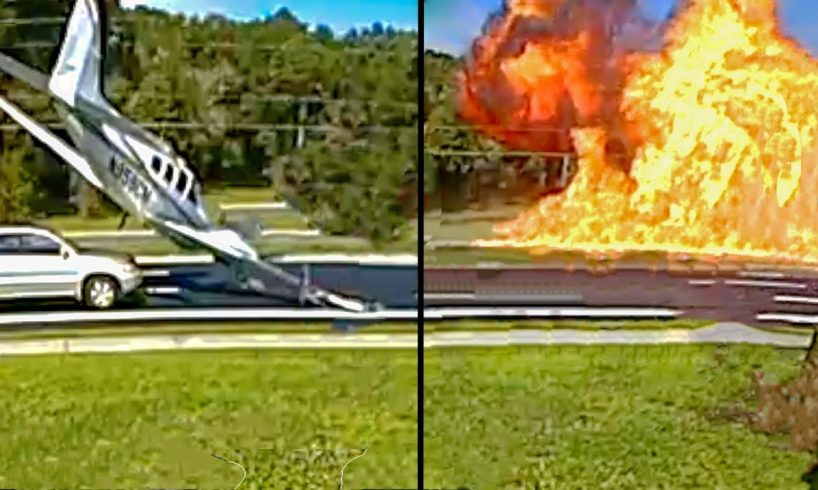
On October 31, 2019, at 1130 eastern daylight time, a Beechcraft BE-58, N959CM, was destroyed after it impacted a vehicle and terrain shortly after takeoff from Ocala International Airport-Jim Taylor Field (OCF), Ocala, Florida. The private pilot and a passenger were fatally injured; one occupant in the vehicle was seriously injured. The airplane was owned and operated by the pilot as a Title 14 Code of Federal Regulations Part 91 post-maintenance test flight. Visual meteorological conditions prevailed, and no flight plan was filed for the local flight that departed OCF at 1128.
According to witnesses, the pilot and a passenger intended to fly a multi-leg cross-country flight to Yuba County Airport (MYV), Marysville, California, and they flew from Punta Gorda Airport (PGD), Punta Gorda, Florida to OCF the day before the accident. The passenger reported that during the flight to OCF the right engine fuel flow meter consistently fluctuated from zero to high; however, the engine’s performance and all other indications appeared normal. An airframe and powerplant mechanic at OCF examined the airplane and subsequently removed the fuel flow transducer from both engines and reinstalled them on the opposing engine to determine if there was an instrument indication problem or an actual fuel flow issue. The pilot and mechanic performed several post-maintenance engine run-ups with no apparent anomalies and then intended to conduct a test flight.
The OCF air traffic controller reported the airplane appeared lower and slower than expected, and that he had instructed the pilot to proceed westbound. The controller queried the pilot regarding the airplane’s heading, the pilot responded they were heading to the west as instructed, and the controller advised that the airplane was flying eastbound. The controller instructed the pilot to proceed westbound. The airplane continued to fly to the east and the pilot advised the controller that they needed to return to the airport. No additional details for the reason of their request to return to the airport was communicated and no emergency was declared.
Several witnesses near the accident site reported that the airplane was flying southeast at a lower altitude than normal. The airplane continued a “shallow” left turn to the north, towards OCF. The airplane’s wings were wobbling after it completed the turn north, then it leveled off briefly before “nose diving” towards the ground where it impacted a six-lane asphalt highway and struck two vehicles before coming to rest. Additional witnesses reported that the airplane was spinning to the left as it descended.
Video recovered from a nearby vehicle equipped with a camera showed the airplane approach from the southeast in a left spinning descent as it impacted the highway. The airplane stuck the road in a nose and right wing low attitude. During the impact, the fuselage struck a vehicle that was travelling in the westbound lanes. The airplane then skidded across the eastbound lanes, struck a concrete curb, then spun around towards the south as it exploded and became engulfed in flames.
The airplane came to rest in a vacant lot, about 2 miles from the approach end of runway 18.
The pilot held a private pilot certificate with ratings for airplane multiengine land, airplane single engine land, airplane single engine sea, instrument airplane. According to the pilot’s logbook, the pilot had accumulated about 7,800 hours of total flight experience and completed a flight review on October 4, 2019. On February 19, 2019, he was issued a Federal Aviation Administration (FAA) third class medical certificate with a limitation; must wear corrective lenses.
At 1140, the weather conditions reported at OCF included clear sky, wind from 200° at 7 knots, visibility 10 statute miles, few clouds at 2,200 ft, temperature 29°C, dew point 24°C, and an altimeter setting was 30.06 inches of mercury.
The fuel selector handles, and fuel selector valves for their respective engines/fuel tanks were found in the on position. The main landing gear was found in the up and stowed position.
The right engine detached from the firewall and was discovered 3 ft forward of the right wing in an upside-down position. The three-blade propeller hub assembly was severely fractured by impact forces. Two of the blades detached from the hub. The remaining blade exhibited bending and twisting deformation as well as chordwise scraping and leading edge damage.
The four remaining propeller blades were recovered at the scene in various locations around the wreckage site with one of the blades striking a vehicle.
The airplane was recovered and retained for additional examination. Strangely, it is unclear whether the pilot or his mechanic passenger told the Ocala controller that they needed to return to the airfield.
The investigation is ongoing.
source







YouTube has decided to demonetize videos of accidents that show "a strong moment of impact," regardless of context. I produce this channel because I believe that transportation safety is enhanced through transparent and accessible disclosures of the facts. If you find value in this channel's content, please consider supporting my work by clicking "Join" and becoming a channel member today.
There is no difference in perks between membership levels; join at a level that is comfortable for you. Rather than overcommitting, my promise to members is that I will continue to produce this channel's unparalleled content, just as I have for the better part of a decade. You don't have to do anything, and this channel is not going anywhere. I appreciate you all. You make this channel possible.
Man.was.not.meant.to.fly.just.the.birds
Poopie.poopie…
Smooth.as.poopie..
I WAS NOT expecting the aircraft to hit when it did. Holy smokes!
That trash beige suv dodged the death by a few inches
I was fortunate to watch a Boeing 777 take off from directly beside the runway V1 threshold. The speed of the Aircraft was stunning. People u derestimate the speed of Aircraft, especially those already airborne, as there's no point of reference in the sky. Takes a lot of speed and power to keep an aircraft airborne.
Why was the suv tailgating the aircraft
aStupidGecko
What happened with the people in the car? Part of the plane caved in its hood, windshield, and roof.
General aviation is a potential deadly threat to innocent people on the ground…and it always will be…happy flying
Fire looks fake (I’m just asking not a hater)
I was t expecting that! 😢
Jit just spawned wrong
The pilot didn't sound the least bit confident in anything he was doing. ATC probably wanted to ask: "You sure you want to do this?" before he even left the ground!
people are such pieces of shit bro… Same old people just drive along trying to get to their destination not even stopping to see if the victims are okay and at least trying to assist.. WTF… The arrogance of people man
well, at least they were most likely unconscious upon striking the ground, before the fire. bitch of a day
0:56
Gravity is always on… no matter how much humans think they control flight. It will pull you back down quickly. Our HH 60 Pavehawk was shot down in Afghanistan and I haven't gotten over my injuries both mental and physical.
I’m sorry but the ATC did NOT sound defeated at all he sounded very concerned and somewhat confused to what exactly happened. Remember he’s still working. He’s still guiding planes so he needs to stay focused while at the same time the thoughts of what just happened going thru his head. He’s a true professional in every sense of the word. My prayers go out to everyone involved in this tragedy directly and indirectly.
how unlucky do you have to be to get your SUV struck by a god damn plane on a highway?
I bet whoever was drving that had a GREAT story to tell people afterwards
Interesting documents.
الله يرحمهم
Pilot under the influence. RIP
That AIR TRAFFIC CONTROLLER is an ASS !!!! His job is not to make snide comments to pilots who are disoriented and thereby add pressure to their already challenging situation. His job is to assist and to support pilots and to promote flight safety.
He may bear a significant degree of responsibility for that man's tragic death. Get asses like that out of the control tower !!!!
Listen to the polite and helpful assistance of the ground controller who did not demean nor pressure the pilot on the ground.
Well that flight is permanently grounded
Traffic controller is amazing
"reported that during the flight to OCF the right engine fuel flow meter consistently fluctuated from zero to high; however, the engine's performance and all other indications appeared normal." There ya go. They didn't take this seriously and it cost them their lives. If something seems off, even slightly, treat it like an emergency and get it repaired TODAY. Don't just take it into the air and think "meh, probably okay". Why isn't this taught in class?
He also had (according to the toxicology report) Valium and THC in his system!? He was fucking HIGH!!!!?????? He also completely SKIPPED the pre-flight checklist because his booster pumps weren't on, leaving him with no fucking fuel. Honestly can just anyone become a pilot these days?
Remember pilots, when the aircraft begins to have trouble. Just put it down. This pilot passed over a couple of fields that may have taken the airfame but could have saved them. When the aircraft has trouble, let the insurance company buy it. Above all else; AVIATE, NAVIGATE, COMMUNICATE. In that order!
really something to see a plane smash into the ground like that,,,the speed,,,wow